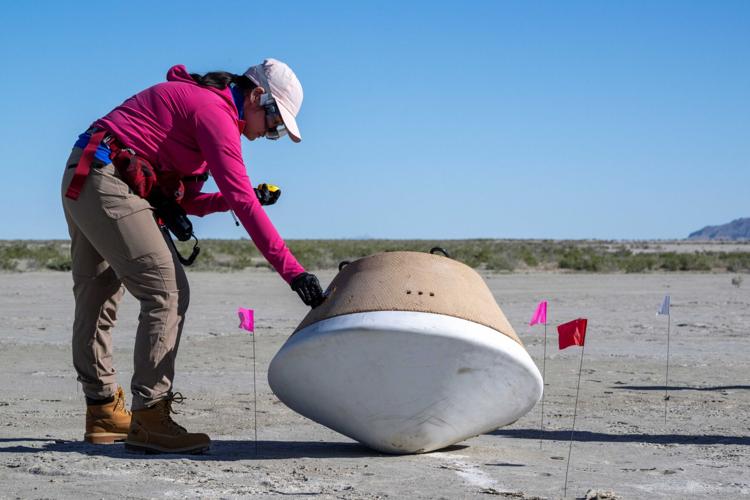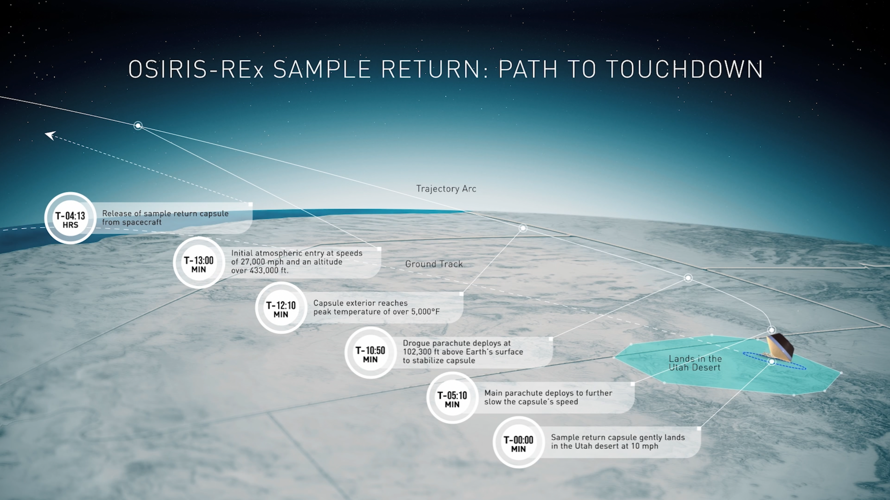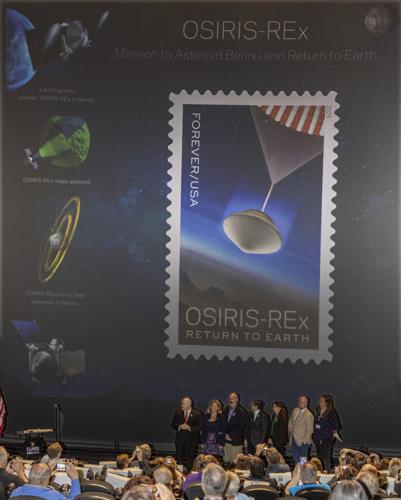The Tucson-born space mission to collect samples from an asteroid will come to an end in the Utah desert on Sunday morning, and you can watch the drama unfold starting at 7 a.m. Tucson time.
NASA will be broadcasting live as the sample-return capsule from the OSIRIS-REx spacecraft streaks through the sky and makes what scientists hope will be a gentle parachute landing at the Department of Defense’s Utah Test and Training Range, west of Salt Lake City.
The capsule carrying rocks and dust from the asteroid Bennu will be traveling at about 27,650 mph when it hits the atmosphere just off the coast of California at 7:42 a.m. Tucson time on Sunday. Its fiery reentry and path to the ground will be tracked with infrared instruments and optical cameras.
After about two minutes, a drogue parachute is expected to deploy to slow the capsule below the speed of sound. Then comes the main parachute, which should unfurl six minutes later and about a mile above the desert to carry the capsule on its five-minute descent to a secure, 300-square-mile landing zone within the military range.

A recovery team member examines a replica of the OSIRIS-REx sample-return capsule duirng a rehearsal in the Utah desert on Aug. 29. The real capsule, packed with rocks and dust from the asteroid Bennu, is set to land at about 7:55 a.m. Tucson time on Sunday.
The mission team is closely watching the weather at and around the landing site. Though the capsule was designed to withstand lightning, ice and anything else it might reasonably encounter in Utah’s west desert in late September, wind remains a concern as the truck-tire-sized reentry package floats down from the sky beneath its parachute.
Wet conditions could also pose a problem, turning the range’s silty soil into cement-like mud that could prevent off-road vehicles from aiding in a search and recovery operation on the ground, should prove to be necessary.
As it stands now, the recovery team, including scientists from the University of Arizona, plans to rush to the landing site in four helicopters to retrieve the prize as quickly as possible to avoid earthly contamination.

A graphic shows the expected sequence of events as the OSIRIS-REx spacecraft releases its sample-return capsule to reenter the Earth’s atmosphere and land in the Utah desert. The capsule carrying material from the asteroid Bennu is expected to make its initial entry into the atmosphere at 7:42 a.m. Tucson time on Sunday.
The capsule will be placed in a harness and attached to a 100-foot-long tether beneath one of the helicopters to be flown back to a staging area at nearby Michael Army Airfield, part of the military’s Dugway Proving Ground.
Once there, the capsule will be whisked into a temporary clean room, where the science canister inside will be prepared and packaged for its flight to its final destination at Johnson Space Center in Houston on Monday morning.

The U.S. Postal Service introduced a new OSIRIS-REx postage stamp during a ceremony Friday at Clark Planetarium in Salt Lake City.
The space agency’s live broadcast will be carried on NASA TV, the NASA app and online at www.nasa.gov/nasalive. Coverage in Spanish will stream through NASA’s social media accounts on X, Facebook and YouTube. The broadcast will end after the capsule arrives at the clean room.
No public watch parties are planned at UArizona, but mission team members not participating in Sunday’s landing will gather to watch it at the Drake Building on Drachman Street and 6th Avenue. The building, which used to serve as headquarters for the OSIRIS-REx science team, is named after UA professor Michael Drake, who led the mission until his death in 2011.
The $1.1 billion journey was launched in September 2016 and arrived at Bennu in 2018.
On Oct. 20, 2020, the robotic spacecraft touched the surface of the asteroid and scooped up about 8.8 ounces of debris that could be as much as 4.5 billion years old and contain secrets about the origins of the solar system and life on Earth.
OSIRIS-REx departed Bennu and began its 1.4 billion mile trip home the following May. As the spacecraft approached Earth, mission engineers adjusted its trajectory with a pair of maneuvers over the past two weeks to line it up for Sunday’s release of the sample-return capsule, which is scheduled to happen at about 3:40 a.m. Tucson time.
The final course adjustment was made on Sept. 17, while OSIRIS-REx was still about 1.8 million miles away.
About 20 minutes after the spacecraft releases the sample-return capsule early Sunday morning, it will fire its thrusters and head back out into space on its next adventure.








